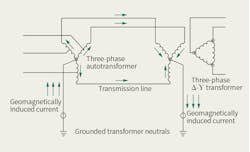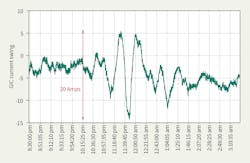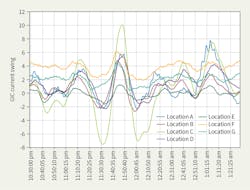Consolidated Edison has made significant progress in assessing the vulnerability of its transmission system to the effects of geomagnetic disturbances (GMDs). The utility has enhanced its operational guidelines to mitigate the effects of geomagnetically induced currents (GICs). Con Edison will invoke these guidelines in case of a GMD event to maintain reliable operation of the transmission system.
Con Edison’s GMD-related initiatives are as follows:
• Asset assessments and GIC capability evaluation for shell-form transformers
• Evaluation of harmonic response of relays and capacitor banks that may be affected by GIC
• Installation of a comprehensive GIC monitoring system
• Enhancement of a system operation procedure for GMD
• Development of a GIC network model for Con Edison’s bulk power system
• Evaluation of the risk of system voltage collapse as a result of increased reactive power demand by saturated transformers in the event of a GMD.
Effects of GMD
GMDs on earth are the result of solar phenomenon such as solar flares and coronal mass ejections (CMEs). The CMEs cause their own current and magnetic fields, which, if they reach earth, can interact with the magnetic field of a planet. The charged particles carried by the CMEs can distort the earth’s magnetic field, inducing voltage potentials in the earth’s crust. This earth-surface potential (ESP) causes GICs to flow in the transmission system. GICs are typically more intense at higher latitudes and in areas of igneous rock geology.
Extra-high-voltage transformers with grounded-neutral connections provide the points of entry and exit for GICs into and out of the power system. The GMD-induced ESP acts as a voltage source applied between the grounded neutrals of wye-connected transformers, which could be located at opposite ends of a long transmission line. The resulting flow between the neutrals constitutes the GICs on the power system.
GICs have very low frequency content (in the range of 0 Hz to 0.2 Hz), thus appearing as a quasi direct current (DC) in comparison to the 60-Hz power frequency. Values of GICs reaching several hundred amperes have been measured in some power systems during extreme GMD events. When the current enters a transformer, it results in a unidirectional DC flux in the core. The magnitude of the flux depends on the magnitude of the GIC, number of turns in the windings carrying the GIC and reluctance of the path of the DC flux. As a result, the DC flux adds an offset to the alternating current (AC) flux, thereby shifting the normal operating region of transformer excitation on the magnetization curve of the transformer.
The shift in the magnetization can cause the transformer to enter into the saturation region on a part-cycle basis. The resulting large asymmetrical magnetization (exciting) current causes the transformer to consume reactive power from the system and produce harmonics. Moreover, this increase in transformer loading can create additional hot-spot heating.
The harmonics introduced also can affect other equipment, such as static volt-ampere-reactive compensators (SVCs) and capacitor banks. The SVCs and capacitor banks are susceptible to tripping because of increased harmonic current during GMDs. The loss of these reactive sources, coupled with the increased reactive losses in the transformers, can cause a chain of events that can compromise the stability of a transmission system greatly.
Con Edison’s 345-kV transmission system covers approximately 600 sq miles (1554 sq km). It is located at 74 degrees west geographic longitude and 41 degrees north geographic latitude (48 degrees geomagnetic latitude), which corresponds to the Piedmont (PT-1) region. It is located in a region of poor soil conductivity (high resistivity).
NERC GMD Standards
On May 16, 2013, the Federal Energy Regulatory Commission (FERC) issued Order No. 779, directing the North American Electric Reliability Corp. (NERC) to develop reliability standards to mitigate the effects of GMD on the transmission system in two stages. Approved by FERC in June 2014, stage 1 was EOP-010-1 Geomagnetic Disturbance Operations.
Stage 2 was NERC Standard TPL-007-1, Transmission System Planned Performance for Geomagnetic Disturbance Events, which requires applicable entities to conduct assessments of the potential impact of benchmark GMD events on their systems. If the assessments identify potential impacts, the standard requires the applicable entity to develop corrective actions to mitigate the risk of voltage collapse, uncontrolled separation or cascading outages. FERC approved the stage 2 standard on Sept. 22, 2016. The latest version of the standard, TPL-007-2 was approved by a majority of NERC members on Oct. 30, 2017. It will be submitted to the NERC Board of Trustees for adoption and filing with the appropriate regulatory authorities.
The NERC GMD task force has also developed the GIC Application Guide, Planning Study Application Guide and Transformer Modeling Guide to help planners assess the potential impacts of GMD on the transmission system. Con Edison’s GMD team participated in the standard development. The company’s comments about the approach to pipe-type cable modeling and the inclusion of phase-angle regulators (PARs) and shunt reactors were addressed by the standard drafting team in the final version.
Con Edison works closely with the New York Independent System Operator Inc. and other New York state utilities in the development of a comprehensive statewide GIC model. This effort will seek to study GIC impacts and determine mitigation strategies for sensitive equipment that may be negatively impacted by high GICs.
Asset Assessment
Con Edison recognized GMD can negatively impact the stability of the power grid. Therefore, the company commissioned assessments to evaluate transmission system equipment such as transformers, high-voltage transmission lines and capacitor banks.
GIC capability evaluations were performed to determine magnitudes as well as the harmonic content of the resulting magnetizing current pulses and corresponding megavolt-ampere-reactive consumption of the transformer design for a wide range of GIC levels. The impact of GIC on losses, core noise level and hot-spot temperatures of the transformer design also was determined for a wide range of GIC pulse levels and time durations. The GIC capability of the transformer design versus load for a high-peak, short-duration GIC pulse also was evaluated.
From these evaluations, Con Edison concluded high-voltage transformers must be monitored. This comprehensive evaluation was on the following four shell-form, three-phase, 60-Hz transformers with more general evaluations being done on all high-voltage and medium-voltage transformers:
• 120-MVA, 13.2/69-kV generator step-up
• 300-MVA, 335/136-kV autotransformer
• 328-MVA, 345/136-kV autotransformer
• 234-MVA, 335/136-kV autotransformer.
Comprehensive GIC Monitoring
Con Edison has installed ECLIPSE, a comprehensive GIC monitoring system, for several of its 345-kV transformers. The monitoring devices are microprocessor based and measure both the transformer temperature as well as the harmonics generated by saturation of the transformers. The devices also measure the GIC entering or exiting the transformer through the grounded neutral, and provide three settable alarms as an output. The monitor can predict when the transformer core undergoes part-cycle saturation by measuring the GIC and harmonics on the outer phases of the transformer.
Different alarms are generated based on a combination of conditions, including the presence of GIC, the presence of certain harmonics and winding hot-spot temperature. The alarms generated, along with measured data such as neutral GIC, transformer temperature and harmonic levels, are sent through the remote terminal unit to the energy control center and are used by system operators to make operating decisions.
GIC Network Model
Assessing GMDs on power systems requires accurate modeling of any expected GICs. Con Edison has developed a comprehensive GIC network model that serves as a crucial tool for GIC calculations. These GIC flow calculations enabled the utility to study the impact of GICs on transformers and contributed to accelerating the replacement of three autotransformers. Furthermore, the GIC model has been refined and expanded in collaboration with the Electric Power Research Institute based on two goals:
• Refine the model to be a reliable tool for transmission planning and system operations. This will enable transmission planning to investigate the predicted reactive power losses from GIC flows in load flow simulations and plan corrective actions to mitigate voltage issues.
• Assess the effects of using a neutral blocking device.
In March 2012, Con Edison participated in a detailed GIC study of the New York state transmission system. The study aimed to calculate the levels of GIC flow during storm scenarios. It identified transformers that are likely to experience high levels of GIC.
Historical Use Cases
Since the installation of the GIC monitoring system in 2014, numerous GMD events have been recorded. During one event, a large GIC swing of a 20-A magnitude (+5 to -15) was recorded. GIC swings at other Con Edison locations were recorded during the same event at around the same time period.
During these events, Con Edison has observed that GIC activity in the neutrals of monitored transformers correlates with the GMD alert periods. However, the observed GIC flows have had little impact on the equipment or system voltages so far.
Moreover, DC current swings have occurred for events as low as K5 as reported by NOAA while higher reported event periods have resulted in lower current measurements. This lack of direct correlation is a good indication that there are many other variables involved in determining the impact of GICs, and solar activity in general, on the power system.
Moving Forward
Con Edison has taken significant steps to ensure the reliability of its transmission system when it comes to GMD. Vulnerability assessments, GMD monitoring system and GIC network modeling have aided the utility in studying the impact of GMD. Various steps such as an operator action plan, resiliency transformers and accelerated transformer replacement programs further solidify the utility’s stance on reliability and dependability.
More work is required, however, to better understand the effects of GMDs on the power system and to help validate models currently being used to predict GMD impact. To that end, Con Edison plans to do the following:
• Conduct GIC capability assessments on reactors and PARs, which will enable the utility to validate its transmission system GIC network model further
• Understand the implications of GIC on underground pipe-type cable
• Install a magnetometer to fully reconcile differences between actual variations in the local geomagnetic field and GMD alerts, which are based on large-scale regional parameters
• Install additional GIC monitoring devices on transformers, shunt reactors and PARs to collect additional data to understand the effects of GMD on the transmission system.
Acknowledgement
The success of the GMD project was made possible by the contributions of many individuals. Special thanks to Gary Hoffman and the Advanced Power Technologies team for working closely with Con Edison in the implementation of the GMD monitors. And thanks to members of the Con Edison team, including Sergo Sagareli, Matt Koenig, Zahid Qayyum, Haseeb Rehman, Sam Sambasivan and other individuals, with whose efforts and expertise this was made possible. ♦
Vince Panuccio is an engineer in the relay protection and metering section at Con Edison. With the utility since 2013, he is one of the utility’s subject matter experts for geomagnetic disturbance and intentional electromagnetic interference-related activities, among other things. He holds an MSEE degree from the New York University Tandon School of Engineering.
Anastasia O’Malley is a project manager in the substation equipment section of central engineering and provides technical guidance on the purchase, installation, maintenance and replacement of Con Edison’s power transformer fleet. She holds an MSEE degree from Manhattan College, a BSME degree from Rutgers University and an MBA degree from Fordham University. She is currently an officer of the Doble Engineering Transformer Committee and an active member of the IEEE Power & Energy Society Transformer Committee.
Hibourahima Camara joined the Con Edison transmission planning department in 2011 and has been a relay protection engineer in the control systems engineering department since 2013. He worked at IBM for 10 years as a high-speed analog/mixed-signal designer prior to joining Con Edison. He holds a BSEE degree from the City College of New York and an MSEE degree from the State University of New York at New Paltz.
Check out the January 2018 issue for more articles, news and commentary.








